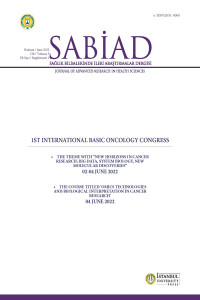Abstract
Background: Radiotherapy is an effective method used in the treatment of lung cancer. However, it is very difficult to assess the clinical manifestations of
radiotherapy at an early stage and the relevant criteria are very limited. Exosome-derived circRNAs (exo-circRNAs) have potential as biomarkers for early
a cancer diagnosis and treatment assessment as exosomes are present in a variety of body fluids and circRNAs in exosomes exhibit high stability. Therefore,
we aimed to investigate for potential biomarker candidates by evaluating changes in exo-circRNA expression with radiotherapy in lung cancer.
Method: In this study, lung cancer epithelial (A549) and healthy lung fibroblast (WI38) cell lines were used. After colony assay, both cell lines were
irradiated with 4 Gy and exosomes were isolated by ultracentrifugation method. Exosomes were characterized by flow cytometry and nanoparticle tracking
analysis, and RNA isolation was performed by trizol protocol. Then, the expression levels of 40 exo-circRNAs in all groups were examined by RT-qPCR.
Results: Of the exosomal circRNA investigated, 5 exo-circRNAs were found to be expressed in at least one of the groups, including A549, WI38, irradiated
A549 and irradiated WI-38 cell lines. In particular, hsa_circ_0014235 and hsa_circ_0001900, which were found to be expressed in all groups, were more
upregulated in cancer cell lines than healthy cell line. Significant changes were detected in the expression levels of these exo-circRNAs after irradiation.
Conclusions: Differential expression of exo-circRNAs between cancer and healthy group and alterations by irradiation suggests that they may be potential
diagnostic and monitoring biomarkers in cancer.
Keywords
References
- Grozescu T, Popa F. Prostate cancer between prognosis and adequate/proper therapy. J Med Life. 2017;10(1):5-12
Abstract
Background: Radiotherapy is an effective method used in the treatment of lung cancer. However, it is very difficult to assess the clinical manifestations of radiotherapy at an early stage and the relevant criteria are very limited. Exosome-derived circRNAs (exo-circRNAs) have potential as biomarkers for early a cancer diagnosis and treatment assessment as exosomes are present in a variety of body fluids and circRNAs in exosomes exhibit high stability. Therefore, we aimed to investigate for potential biomarker candidates by evaluating changes in exo-circRNA expression with radiotherapy in lung cancer.
Method: In this study, lung cancer epithelial (A549) and healthy lung fibroblast (WI38) cell lines were used. After colony assay, both cell lines were irradiated with 4 Gy and exosomes were isolated by ultracentrifugation method. Exosomes were characterized by flow cytometry and nanoparticle tracking analysis, and RNA isolation was performed by trizol protocol. Then, the expression levels of 40 exo-circRNAs in all groups were examined by RT-qPCR.
Results: Of the exosomal circRNA investigated, 5 exo-circRNAs were found to be expressed in at least one of the groups, including A549, WI38, irradiated A549 and irradiated WI-38 cell lines. In particular, hsa_circ_0014235 and hsa_circ_0001900, which were found to be expressed in all groups, were more upregulated in cancer cell lines than healthy cell line. Significant changes were detected in the expression levels of these exo-circRNAs after irradiation.
Conclusions: Differential expression of exo-circRNAs between cancer and healthy group and alterations by irradiation suggests that they may be potential diagnostic and monitoring biomarkers in cancer.
Keywords
References
- Grozescu T, Popa F. Prostate cancer between prognosis and adequate/proper therapy. J Med Life. 2017;10(1):5-12
Details
| Primary Language | English |
|---|---|
| Subjects | Clinical Sciences |
| Journal Section | Meeting Abstract |
| Authors | |
| Publication Date | August 9, 2022 |
| Submission Date | July 6, 2022 |
| Published in Issue | Year 2022 Volume: 5 Issue: S-1 |


